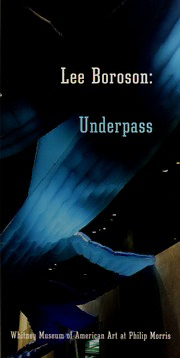
Lee Boroson : underpass. PDF
Preview Lee Boroson : underpass.
Lee Boroson: Underpass Lee Boroson: Underpass October29,1999-March17,2000 WhitneyMuseum ofAmericanArtat Philip Morris TheWhitneyMuseum ofAmericanArt at Philip Morris is fundedbyPhilip MorrisCompanies Inc. Thisbrochureaccompaniestheexhibition "Lee Boroson: Underpass"organizedby Debra Singer,branch curator,WhitneyMuseum ofAmericanArtat Philip Morris. All photographs,unlessotherwise indicated: LeeBoroson. Underpass,1999 (installation view) Page2 (bottom): Lee Boroson. Underpass,1999 (installation detail) © 2000WhitneyMuseumofAmericanArt 945 MadisonAvenueat75th Street NewYork,NY 10021 www.whitney.org Surface Tension Hoveringoverhead, across the expansive span ofthe Philip Morris Sculpture Court, are the flowing curves and forceful lines ofLee Boroson's luminous fabric sculpture, Underpass. The piece, despite its immense size,appears surprisinglyairy and light,as its overlappinghorizontal planes ofblue and white counterthe toweringverticalityofthe 42-foot-high surroundingwalls. Created from a translucent, silkymaterial generallyusedto make parachutes, the sculpture takes advan- tage ofthelarge glasswindows on all sides and diffuses light in dramaticways. How, and towhat extent,thepiece refracts the artificial and natural light depends on the time ofday and on shifts in theweather. Bytemporarilychanging the configurations ofthe architecture and reflecting colorand light, Underpasstransforms the atmosphere ofthis unusual atrium-like settingand alters ourphysical perceptions of beingin,and movingthrough,the Sculpture Court. Gazingupward at Underpass,you might imagine that the outdoorshas movedin andthatyou standbeneath askyor a running river. Thework's organic feel is enhancedbyair currents,originatingfrom a fan embedded in thebuilding's crawlspace,whichpulse through the piece, causing itto billow and sway, as ifitwere aliving,breathingcreature.As the title suggests,however,the sculpture's form relates to more than naturalphenomena. The structure is also associatedwith highwaydesign,specificallyacloverleaftraffic exchangepattern. In thistype ofroadsystem (and in the sculpture itself),four individual circles loop around a central straightthrust, creating alinearscheme that resembles afour-leafclover. World'sFirstCloverleafInterchangenearWoodbridge,NJ, Builtin192S. NewJerseyDepartmentofTransportation,Trenton In its practical application, this arrangement allows for efficient change ofdirection and speed as cars enterorexit the highway. In this museum context,however,the pattern mirrorsvarious properties unique to the Sculpture Court. The form echoes theviews onto the bustling intersection of42nd Street and ParkAvenue,which reveal two levels of cartraffic on the street and elevatedbridge. It also resonates with the unusual diagonal path ofpedestrians as theywalk across the space from one entrance to another. 2 Underpassequallytakes into account the function ofthe buildingto which the Sculpture Court is attached.While — the Sculpture Court is essentiallya leisure space an urban garden where people stop to enjoya cup ofcoffee or eat — lunch the rest ofthebuilding is a workplace, namely, the international corporateheadquarters ofPhilip Morris Companies. To Boroson,the cloverleafroad design is also an appropriate metaphor forthekindofstreamlined transferof 6 — information and flowofcommunication that are fundamental to runningaproductivebusiness. Such directed"transfers"and"flows"ofpeople, cars,or dataalludetowhat Boroson refersto as"navigation systems" structural arrangements designed to guide ourmovements andconsequentlyaffecthowwecomprehendoursurroundings. Such systemsaremimickedwithinthepieceitself: air,propelled byan energysource, is routed through quilted channels, 7 promptingexchangesbetween energyand matterthat result in noticeable fluctuations ofthe sculpture's form. Boroson's interest in"navigation systems"ledhim to study notonlyhighwayplanningand roaddesignbut also traditional French,Dutch, and German formal gardens. Despite their opposingpurposes,both utilitarian road plans and traditional recreational gardens sharemanyformalcharacteristics. Boroson explains,"Although conceptuallyyou maynot thinkhighway and garden layouts have much in common,when you lookat photographs and diagrams ofaerial perspectives,theypossess manysimilargeometries."1 Many formal gardens are designed, forexample, against abasic grid scheme that then allows for the orderlydevelopment ofintersections and pathways.As a result, schematic maps ofroads and gardens can sometimes look remarkablyalike. Boroson's analogous applications ofsuch layouts to his workbecome apparent bycomparing Underpassto Pleasure Grounds(1999). In this latter installation,a gridlikearrangement ofhanging,green-and-white,circular, pneumatic forms skim the surface ofthe floor. Unlike the experience ofwalking through an actual garden,whereyou are in the thickofthings, thisworkplaces theviewer in the position oflookingdown on an artificial garden and surveyingthe entire plan at a glance. An imaginaryworld is invoked here, not only through the privilege ofan aerial perspective,but also through Boroson's deceptive use ofscale. On the one hand,each ofthe dangling units suggests an outsized floweror floatinglily pad. On the other, each component can also be interpreted as a condensed groupingof"vegetation,"implyingthat an entiregarden has nowshrunkto Lilliputian proportions. The elements are simultaneouslytoo bigand too tinyto be reconciled with any notions ofreality. Underpasssimilarlymanipulates vantage and scale.As viewers,we are placed in the fantastical position ofstanding underneath an unsupportedexpressway,an indoorsky,orthe water's surface. Thesevarious imaginaryassociations draw attention to the relativityofscale. Despite its impressive 8
